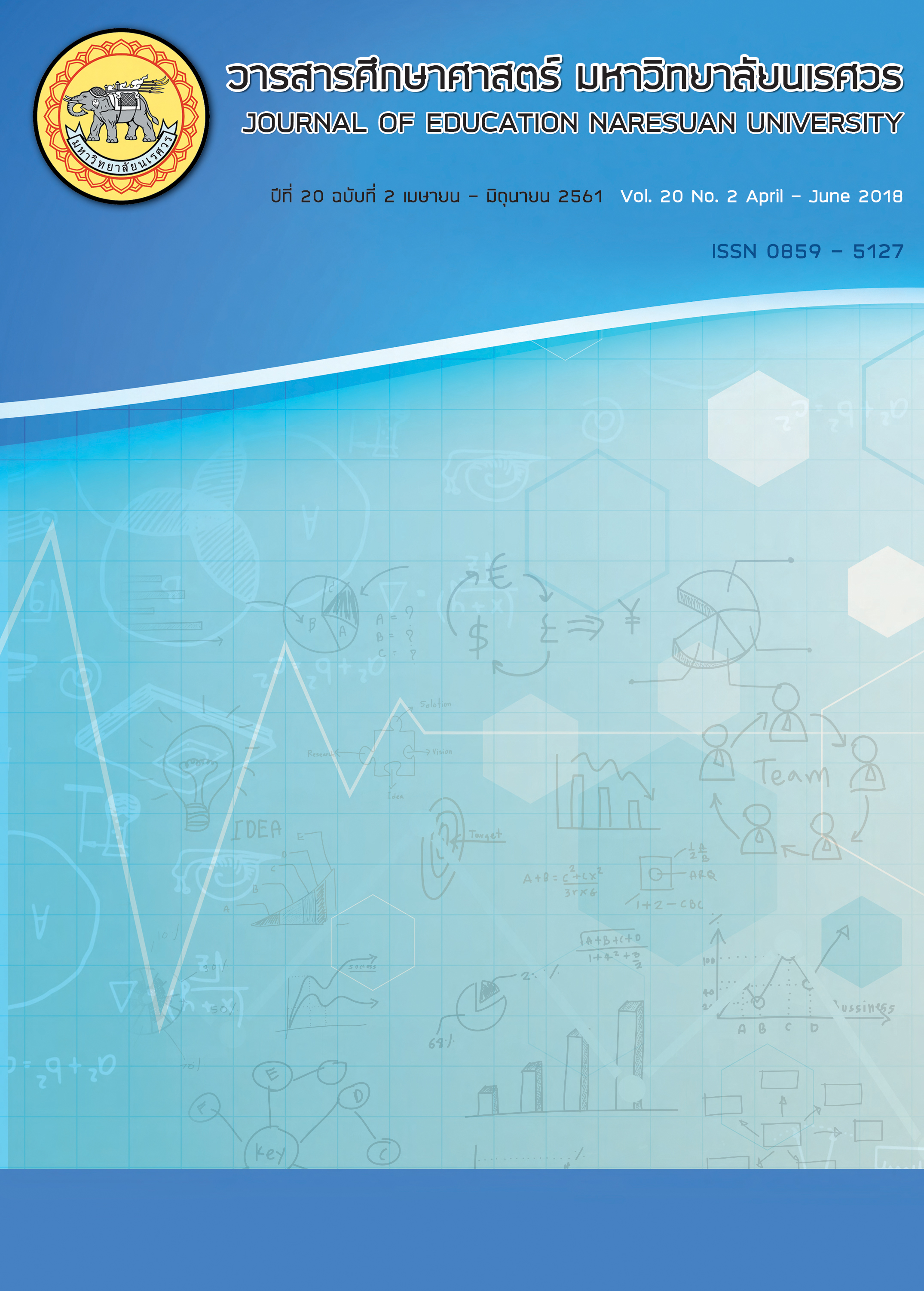การพัฒนามโนทัศน์ทางวิทยาศาสตร์ เรื่อง การจัดจำแนกพืชและสัตว์ โดยใช้วิธีการสอนแบบกลวิธี ทำนาย – สังเกต – อธิบาย ของนักเรียนชั้นประถมศึกษาปีที่ 5; THE DEVELOPMENT OF SCIENTIFICCONCEPT ON CLASSIFICATION OF PLANT AND ANIMAL BY USING...
Main Article Content
Abstract
งานวิจัยนี้มีจุดประสงค์เพื่อพัฒนามโนทัศน์ทางวิทยาศาสตร์ เรื่อง การจัดจำแนกพืชและสัตว์ โดยใช้วิธีการสอนแบบกลวิธีทำนาย-สังเกต-อธิบาย ของนักเรียนชั้นประถมศึกษาปีที่ 5 กลุ่มตัวอย่าง ได้แก่ นักเรียนชั้นประถมศึกษาปีที่ 5/1 โรงเรียนหนองแปนโนนสูงนาเชือกราษฎร์บำรุง จังหวัดกาฬสินธุ์ ภาคเรียนที่ 2 ปีการศึกษา 2558 จำนวน 25 คน ที่ได้มาโดยการเลือกแบบเจาะจง เครื่องมือที่ใช้ในการวิจัย ได้แก่ แผนการจัดการเรียนรู้ แบบวัดมโนทัศน์ทางวิทยาศาสตร์ เรื่อง การจัดจำแนกพืชและสัตว์ เป็นแบบปรนัย 4 ตัวเลือก และมีการให้เหตุผลประกอบ จำนวน 15 ข้อ การวิเคราะห์ข้อมูลใช้การวิเคราะห์เนื้อหาแล้วจัดมโนทัศน์ทางวิทยาศาสตร์ ออกเป็นกลุ่ม 5 กลุ่ม ได้แก่ 1) ความเข้าใจมโนทัศน์ที่สมบูรณ์ 2) ความเข้าใจที่ถูกต้องแต่ไม่สมบูรณ์ 3) ความเข้าใจที่คลาดเคลื่อนบางส่วน 4) ความเข้าใจที่คลาดเคลื่อน 5) ความไม่เข้าใจ และวิเคราะห์ข้อมูลโดยใช้สถิติ คือ ค่าเฉลี่ย ค่าเบี่ยงเบนมาตรฐานและค่าร้อยละ ผลการวิจัย พบว่า ก่อนเรียนนักเรียนมีมโนทัศน์ที่คลาดเคลื่อน จำนวน 16 มโนทัศน์ นักเรียนมีค่าเฉลี่ยหลังเรียนสูงกว่าก่อนเรียน โดยมีคะแนนเฉลี่ยก่อนเรียน เท่ากับ 5.24 และหลังเรียนเท่ากับ 33.80 และโดยภาพรวมนักเรียนมีความเข้าใจมโนทัศน์ทางวิทยาศาสตร์สูงขึ้นและจำนวนนักเรียนที่คลาดเคลื่อนลดลง ซึ่งก่อนเรียนนักเรียนส่วนใหญ่มีความเข้าใจมโนทัศน์ที่คลาดเคลื่อน (AC) คิดเป็นร้อยละ 61.60 ความเข้าใจมโนทัศน์ที่คลาดเคลื่อนบางส่วน (PS) คิดเป็นร้อยละ 24.00 ความไม่เข้าใจ (NU) คิดเป็นร้อยละ 8.26 และความเข้าใจมโนทัศน์ถูกต้องแต่ไม่สมบูรณ์ (PU) คิดเป็นร้อยละ 5.60 แต่หลังจากที่ได้เรียนรู้โดยใช้วิธีการสอนแบบกลวิธีทำนาย-สังเกต-อธิบาย แล้วนักเรียนมีความเข้าใจมโนทัศน์ที่ถูกต้องมากขึ้นและมีความเข้าใจมโนทัศน์ที่คลาดเคลื่อนลดลง ซึ่งจะเห็นได้จาก ความเข้าใจที่ถูกต้องแต่ไม่สมบูรณ์ (PU) คิดเป็นร้อยละ 44.80 ความเข้าใจที่สมบูรณ์ (CU) คิดเป็นร้อยละ 40.80 และความเข้าใจมโนทัศน์บางส่วน (PS) คิดเป็นร้อยละ 14.66
THE DEVELOPMENT OF SCIENTIFICCONCEPT ON CLASSIFICATION OF PLANT AND ANIMAL BY USING PREDICT-OBSERVE-EXPLAIN (POE) TEACHING METHOD WITH GRADE 5 STUDENTS
The purpose of the research was to develop the understanding of scientific concept which is the classification of plants and animals by using Predict-Observe-Explain (POE) strategy for Grade 5 students. In Nongpannonsungnacheuakratbamrung School, Kamalasai district, Kalasin province. The target group of study was Grade 5/1 students in second semester of academic year 2015. Twenty five students were selected by purposive sampling method. The research instrument were the lesson plan and the scientific concept test in term of the classification of plants and animals consists of 15 multiple choice questions with 4 alternative by giving the reason to support the answer. Data analysis is considered by contents, and divided the scientific concept into 5 parts which are; 1) Complete Understanding, 2) Partial Understanding, 3) Partial Understanding with Specific, 4) Alternative Conception, and 5) No Understanding. Moreover, statistical analysis is also used for analyzing the data including percentage, arithmetic mean and standard deviation (S.D.). The study shows that student had 16 the scientific concept of plant and animals error before the lesson. Besides, the understanding score after lesson is higher than the previous. The average score of students before and after the lesson are 5.24 and 33.80 and developing concept of students are higher and lower number of misconception. The Alternative Conception (AC) of student before the lesson is 61.60 percentage, The Partial Understanding with Specific Alternative Conception (PS) of student before the lesson is 24.00 percentage, 8.26 percentage of student with No Understanding (NU) before the lesson, and 4.60 percentage of student who have Complete Understanding (CU) before the lesson. However, after the lesson which using Predict-Observe-Explain (POE) strategy showed that Complete Understanding (CU) percentage is 40.80 which are higher, The Partial Understanding (PU) percentage is 44.80 and The Partial Understanding with Specific Alternative Conception (PS) is 14.66 percentage.
Article Details
The owner of the article does not copy or violate any of its copyright. If any copyright infringement occurs or prosecution, in any case, the Editorial Board is not involved in all the rights to the owner of the article to be performed.
References
Bamrungrai, K. (2010). The development of scientific concept about force and motion for grade 7 students' by Predict-Observe-Explain (POE) learning activities (Master thesis). Khon Kaen: Khon Kaen University. (in Thai)
Chanserm, N. (2008). The grade 10 students' learning outcomes of work and energy based on constructivist theory through Predict-Observe-Explain (POE) (Master thesis). Khon Kaen: Khon Kaen University. (in Thai)
Wiyo, P. (2008). The results of instruction to remediate alternative conceptions of biology for Mathayumsuka VI students on genetic using supplementary book based on posner and the oters' theory (Master thesis). Khon Kaen: Khon Kaen University. (in Thai)
Visetkaew, P. (2010). The development of scientific conceptions about force and pressure of grade 5 students using predict - observe - explain (POE) (Master thesis). Khon Kaen: Khon Kaen University. (in Thai)
Rodrangka, W. (1997). Constructivism. Bangkok: Faculty of Education Kasetsart University. (in Thai)
Srivannawong, S. (2010). Scientific conception heredity of Mathayomsuksa VI students using conceptual change strategies. Journal of Education Graduate Studies Research Khon Kaen University, 4(special), 26-32. (in Thai)
Institute for the Promotion of Teaching Science and Technology. (2002). A science learning handbook. Bangkok: Ministry of Education. (in Thai)
Kijkuakul, S., & Yutakom, N. (2004). A study of level 4 students' photosynthesis conceptions. Kasetsart Journal of Social Sciences, 25(2), 139-149. (in Thai)


